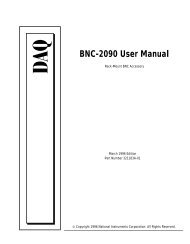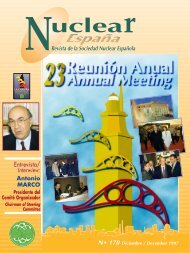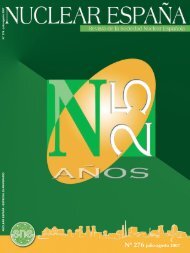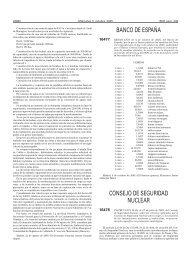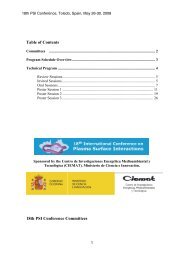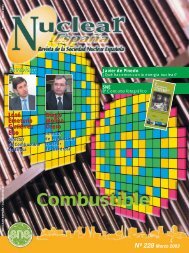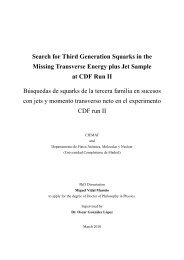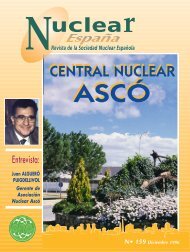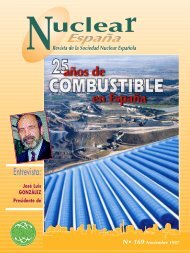EntrEntr evista/evista/ InterInter viewview
EntrEntr evista/evista/ InterInter viewview
EntrEntr evista/evista/ InterInter viewview
Create successful ePaper yourself
Turn your PDF publications into a flip-book with our unique Google optimized e-Paper software.
ENTREVISTA/INTERVIEW<br />
das para llegar, a establecer un programa<br />
un de adecuación de los recursos».<br />
OBJETIVOS<br />
La gestión unificada de Almaraz y<br />
de Trillo integra el desarrollo de los<br />
proyectos de ambas centrales como<br />
un todo y plantea, bajo una misma<br />
organización, los objetivos a alcanzar<br />
por ambas plantas. Como explica<br />
su Director General, «hemos definido<br />
un esquema de Proyecto de<br />
Empresa donde se establece que la<br />
misión de la gestión unificada de<br />
Almaraz-Trillo es producir energía<br />
eléctrica de forma segura, fiable,<br />
económica y respetuosa con el medio<br />
ambiente, garantizando la producción<br />
a largo plazo y, además, situar<br />
a las centrales nucleares de<br />
Almaraz y Trillo entre las de referencia<br />
en seguridad, calidad y coste.»<br />
A corto y medio plazo, los objetivos<br />
planteados son:<br />
• Organización única, que ya está<br />
lograda y establecida.<br />
• Oficina común, terminada y organizada<br />
en el mes de abril de 2000.<br />
• Presupuestación conjunta, que<br />
ya está establecida.<br />
• Plan de negocio, que ya está<br />
elaborado y presentado a las empresas<br />
propietarias.<br />
• Sistema único de información y<br />
comunicación, en el que se está trabajando.<br />
• Integración y utilización conjunta<br />
de los procesos de las dos organizaciones.<br />
• Plan de recursos.<br />
• Plan de inversiones para mantener<br />
las centrales en el debido estado<br />
de r<strong>evista</strong>.<br />
«Entre los objetivos prioritarios<br />
que nos hemos marcado está el de<br />
movilizar a las personas para conseguir<br />
la integración eficaz de las políticas<br />
y las actuaciones, y alcanzar un<br />
funcionamiento ágil, responsable y<br />
optimizado. Todo el análisis para la<br />
optimización de la organización lo<br />
hacemos teniendo en cuenta que<br />
hay que mantener la capacidad actual,<br />
buscando la formación del personal,<br />
dentro de una política de creación<br />
de equipos de trabajo que<br />
cree una motivación y participación<br />
de las personas, mediante un aplanamiento<br />
de las estructuras para que<br />
todo el mundo se sienta más protagonista<br />
de sus actuaciones y lograr,<br />
en definitiva, modernizar nuestra organización.<br />
»También es muy importante el<br />
papel de los contratistas, que aportan<br />
en estos momentos unas 400<br />
personas a la plantilla, y la política<br />
que vamos a seguir es la de unificar<br />
contratistas entre las dos instalaciones<br />
porque eso se ajusta a una de las<br />
líneas de optimización de la organización.<br />
Además, buscamos una potenciación<br />
y una mayor capacidad<br />
de esos contratistas, ya que les estamos<br />
asegurando un mercado más<br />
importante.<br />
»Otro objetivo muy importante en<br />
este tipo de instalaciones es el que<br />
se refiere a la gestión de vida útil de<br />
las centrales. Éstas tienen que funcionar<br />
siempre dentro de los requisitos<br />
de seguridad establecidos.<br />
Somos los primeros interesados en<br />
ello y no vamos a escatimar esfuerzos,<br />
de modo que vamos a hacer las<br />
inversiones necesarias para que funcionen<br />
correctamente como hasta<br />
ahora y no tener problemas, ni desde<br />
el punto de vista de la operación<br />
inmediata ni en lo referente a la vida<br />
de las centrales. Una parte fundamental<br />
del presupuesto está destinado<br />
al mantenimiento preventivo, la<br />
sustitución de equipos y las modificaciones<br />
de diseño que mejoren las<br />
condiciones de la planta.»<br />
El proceso de gestión unificada se<br />
asocia, inevitablemente, a la reducción<br />
de costes. A este respecto,<br />
Eduardo González es claro. «La reducción<br />
de costes no es sólo un objetivo<br />
en sí sino que debe producirse<br />
como consecuencia de la propia<br />
unificación. Una mejora continua de<br />
nuestras capacidades nos lleva a una<br />
optimización de la organización<br />
que, a su vez, tendrá como consecuencia<br />
una reducción de costes, ésta<br />
es el producto de un trabajo bien<br />
hecho. Además, si nos fijamos en las<br />
estadísticas históricas, se puede<br />
comprobar que las centrales que tienen<br />
mayor disponibilidad son las<br />
que cuentan con mejores índices de<br />
seguridad y, a la vez, también son las<br />
que tienen menores gastos.»<br />
ESTRUCTURA DE ALMARAZ-<br />
TRILLO A.I.E.<br />
De manera muy sencilla, Eduardo<br />
González resume cuál es la estructura<br />
de esta nueva asociación: «tenewhole<br />
and, under the same organization, proposes<br />
the objectives to be achieved in both plants. As its<br />
General Director explains, “we have defined a<br />
Corporate Project plan which establishes that the<br />
mission of the Almaraz-Trillo unified management is<br />
to produce electric energy in a safe, reliable,<br />
economic and environmentally friendly way,<br />
guaranteeing long-term production and also ranking<br />
the Almaraz and Trillo nuclear power plants among<br />
the reference plants in terms of safety, quality and<br />
cost.”<br />
The short- and medium-term objectives are as<br />
follows:<br />
• Single organization, which has already been set<br />
up.<br />
• Common office, completed and organized in<br />
April 2000.<br />
• Joint budgeting, which is already established.<br />
• Business plan, which has been prepared and<br />
submitted to the owner utilities.<br />
• Single information and communications system,<br />
which we are working on.<br />
• Integration and joint use of the two<br />
organizations’ processes.<br />
• Resource plan.<br />
• Investment plan to keep the plants in proper<br />
operating condition.<br />
“The priority objectives that we have set for<br />
ourselves include mobilizing people to achieve<br />
effective integration of policies and actions, and<br />
achieving flexible, responsible, optimized operation.<br />
All our analyses for optimizing the organization take<br />
into account that current capabilities must be<br />
maintained on the basis of personnel training, as part<br />
of a policy of creating job teams to motivate and<br />
make people participate, through a leveling off of the<br />
structures so that everyone can feel they are masters<br />
of their acts. In short, we intend to succeed in<br />
modernizing our organization.<br />
“The contractors’ role is also very important. At<br />
this time they have 400 people on staff, and the<br />
policy that we are going to follow is to unify<br />
contractors between the two facilities, because this<br />
conforms with one of the lines of optimization of the<br />
organization. In addition, we want to see these<br />
contractors improve their capability, as we are<br />
assuring them a very important market.<br />
“Another major objective in this type of facility<br />
has to do with management of the plants’ effective<br />
lifetime. The plants must always operate in<br />
accordance with established safety requirements.<br />
We are the first to benefit from this and we will spare<br />
no efforts, and thus we will make the investments<br />
required for the plants to continue operating<br />
properly and for preventing problems related both to<br />
immediate operation and to plant lifetime. A<br />
substantial part of the budget is earmarked for<br />
preventive maintenance, equipment replacement<br />
and design modifications that enhance plant<br />
conditions.”<br />
The process of unified management is inevitably<br />
associated with cost reduction. In this respect,<br />
Eduardo Gonzalez is clear: “Cost reduction is not<br />
only an objective in and of itself, but it also should<br />
occur as a result of the very unification process.<br />
Continuous improvement of our capabilities results<br />
in optimization of the organization, which in turn<br />
results in cost reduction; this is the product of a job<br />
well done. In addition, if we look at the historical<br />
statistics, we can see that the plants with the highest<br />
availability indices are the ones with the best safety<br />
indices and at the same time with the lowest costs.”<br />
A b r i l 2 0 0 0<br />
R e v i s t a S N E




